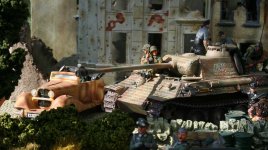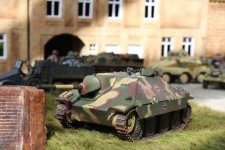The rail movement of the initial
attack divisions had nearly ended by 11
December, although the transport of the
second phase formations, belonging to
the OKW reserve, still had a few days
to go. The Seventh Army, quondam
caretaker on the Ardennes front, had
most of its divisions in the line but in
the nights just before the attack would
have to shift some of these southward
into the final assembly area designated
for the Seventh on the attack left wing.
The Fifth Panzer Army, slated to make
the attack in the center, had begun its
concentration in the Remagen-Mayen
area of the Eifel as early as 26 November,
but some of its armor was coming from
as far north as Munchen-Gladbach–one
attack division, the 116th Panzer, would
not complete detraining until 16 December.
The Sixth Panzer Army, which in
Hitler’s mind and in OKW plans represented
the main effort and whose
four SS panzer divisions were expected
to pace the entire counteroffensive, by
6 December had closed its armor in a
zone stretching from west of Cologne
to southwest of Bonn.
The question remained whether the Sixth infantry
divisions, some of which were in the
Roer battle line, could be pried loose
and moved south in time for H-hour.
The Fifteenth Army, once intended to
cover the north flank of the Sixth Panzer
Army advance, had its hands full on the
Roer front. Here there was no immediate
assembly problem, although the
army would have to plug the gaps left
as divisions pulled out for the Ardennes.
Ultimately, however, the Fifteenth
might be reinforced from the OKW reserve
and join the attack. If the Fifteenth
Army is excluded the German
attack front extended for 143 kilometers
(89 miles).
The main armored concentration,
however, would take place
on a frontage of 97 kilometers (61
miles) .
The timetable for final assembly in
attack positions required three days, or
better, three nights, since nearly all
movement would be confined to hours
of darkness.
To prevent premature disclosure
by some unit wandering into
the assembly area, all formations except
those already deployed on the original
Seventh Army front or immediately
behind it were banned from crossing
the Army Group B base line, twelve
miles behind the front, until the final
assembly was ordered by Hitler.
Once across the base line every movement had
to follow rigid timing. For further control
the infantry and armored divisions
were each assigned two sectors for assembly.
Infantry Area I was marked by
a restraining line six miles from the
front; Area 11 extended forward to
points about two and a half to three
miles from the front.
Armor Area I
actually was east of the base line which
served as the forward restraining line;
Area 11 was defined by a line six to ten
miles from the front. The armored
divisions, of course, would be strung out
over greater distances than given here
but their assault echelons would be
fitted inside the two armored areas.













